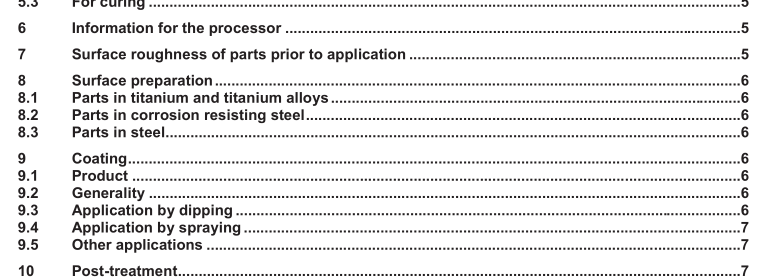EN 2491:2011 – Aerospace series – Molybdenum disulphide dry lubricants – Coating methods

1 Scope
This European Standard defines the coating methods and characteristics of molybdenum disulphide dry film lubricants which may be applied to parts in titanium, titanium alloys, steel, corrosion resistant steel and nickel based alloys.
2 Purpose of process
To reduce wear, risk of seizing and, in some cases, fretting corrosion.
3 Normative references
The following referenced documents are indispensable for the application of this document. For dated references, only the edition cited applies. For undated references, the latest edition of the referenced document (including any amendments) applies.
EN 2133, Aerospace series — Cadmium plating of steels with specified tensile strength ≤ 1 450 MPa, copper,copper alloys and nickel alloys
EN 2516, Aerospace series — Passivation of corrosion resisting steels and decontamination of nickel base alloys
EN 9100, Quality Management Systems — Requirements for Aviation, Space and Defense Organizations
EN ISO 1463, Metallic and oxide coatings — Measurement of coating thickness — Microscopical method
EN ISO 2431, Paints and varnishes — Determination of flow time by use of flow cups (ISO 2431:1993,including Technical Corrigendum 1:1994)
EN ISO 2884 (all parts), Paints and varnishes — Determination of viscosity using rotary viscometers ISO 2859-1, Sampling procedures for inspection by attributes — Part 1: Sampling schemes indexed by acceptance quality limit (AQL) for lot-by-lot inspection
ISO 8080, Aerospace — Anodic treatment of titanium and titanium alloys — Sulphuric acid process ASTM D 2510:1983, Standard test method for adhesion of solid film lubricant 1)
TR 4070, Aerospace series — Molybdenum disulphide coatings list of commercial products
4 Terms and definitions
For the purposes of this document, the following terms and definitions apply.
4.1
batch
parts subjected to the same dry lubricant application at the same time under the same condition
4.2
pre-production parts
parts representing future production
5 Apparatus
5.1 For application by dipping
Container with a lid, stirring device and temperature control.
The apparatus shall be capable of applying the specified thickness, for example by controlling the speed of immersion and removal and by draining or centrifuging the parts.
5.2 For application by spraying
A dry, oil free air fed gun shall be used, with settings adapted to the characteristics of the dry lubricant used and to the shape of the parts to be coated.
Preferably a mechanical stirring device in the reservoir.
NOTE 1 A device allowing for rotation of the parts to be coated and the automatic displacement of the gun will give a more uniform application.
NOTE 2 Use of an aerosol spray does not always ensure acceptable reproducibility. Moreover, the propellant shall not have any adverse effect on the substrate.
5.3 For curing
An oven capable of temperatures prescribed by the lubricant manufacturer.
6 Information for the processor
Designation of the dry lubricant;
number of the material standard and metallurgical condition of the latter;
areas to be processed;
thickness of the dry lubricant, if necessary, (see Table 1);
duration and temperature of curing.
7 Surface roughness of parts prior to application
It shall be specified on the drawing or in the definition documents.
EN 2491:2011 – Aerospace series – Molybdenum disulphide dry lubricants – Coating methods